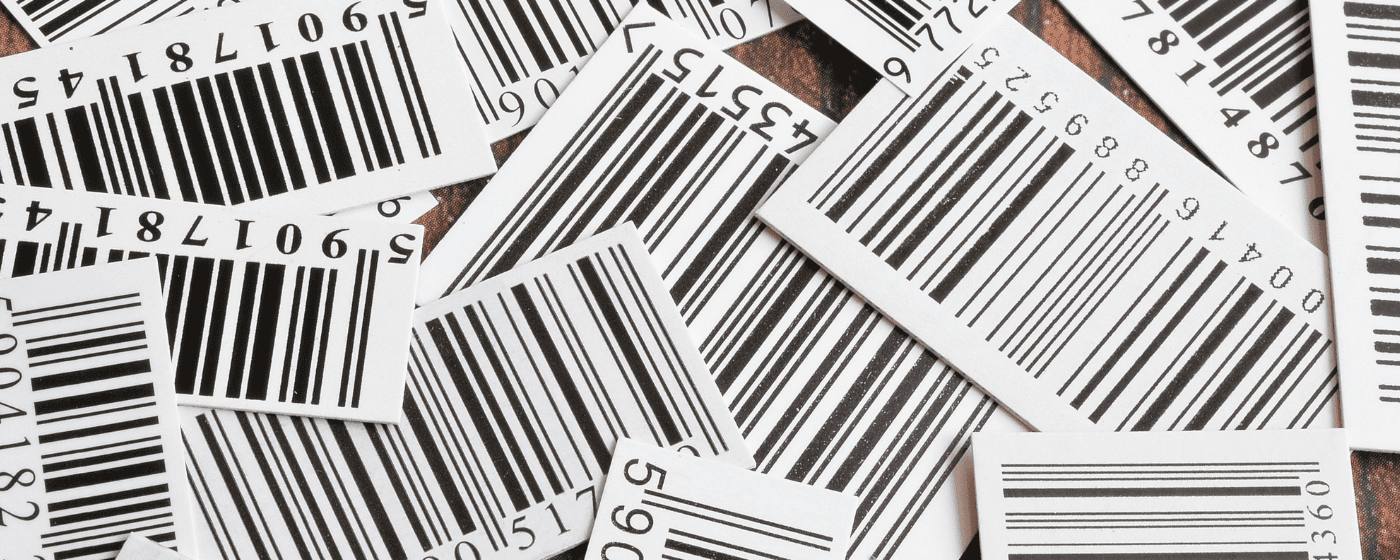Successful ecommerce brands are built on organisation – and to run a well-organised ecommerce operation, you need to have an equally well-organised method of tracking and identifying your products.
Most brands create unique SKUs (stock keeping units), and use these labels internally to distinguish different products. But what happens when you start selling your products in new channels or countries? If every brand were to insist on using its own labelling system, it would be difficult – even impossible – to sell your products in other marketplaces.
That’s why universal product codes, or UPCs, are important. UPCs give ecommerce brands across the globe a standardized way to identify, label, and distinguish their products. This system not only makes collaborative selling easier, but can also help your brand improve its inventory management and tracking.
In this post, we’ll explore UPC codes: what they are, how real companies use them, and how ShipBob leverages product codes and best practices to optimise fulfilment for ecommerce brands.
What are universal product codes?
A Universal Product Code, or UPC, is a universally unique numerical code and corresponding barcode assigned to a product. When scanned, the barcode reveals important information about the product such as brand name, size, price, and more.
This code is used by warehouses and point-of-sales systems to keep track of inventory and sales. UPCs remain constant regardless of who is selling the product, where it is sold, or how it is sold.
UPCs can be up to 12 digits, and typically include three main components:
1. Manufacturer identification number – The first six to nine digits of the UPC is the manufacturer identification number. The nonprofit organisation GS1 assigns a unique six-digit prefix to every business, which helps identify who owns the intellectual property rights to that product. This means that if two different products were created by the same small business, those products’ UPCs would have the same first 6 digits.
2. Item number – The next five digits make up the item number of the product. This is unique to each product and product variation. For example, a yellow sweater should have a different item number than a green sweater of the same design.
3. Check digit – The final digit is a check digit, which is used to validate the UPC in your POS or inventory management system. This digit is the sum of all the previous digits, which ensures that no two UPCs are the same. A correct check digit is necessary for the UPC barcode to scan properly and present the item details for the correct product.
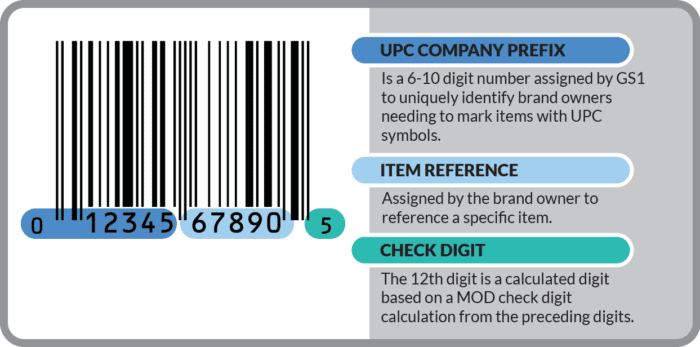
The importance of UPC numbers in ecommerce
Ever since its creation and launch in 1973, the UPC has transformed how brands do business. Here are just some of ways that UPCs have impacted and benefitted ecommerce for customers and brands alike.
They make transactions more efficient
Before barcodes existed, cashiers in physical stores had to manually type in and ring up the price for every individual item. This ate up enormous amounts of time, took a lot of effort and precision, and caused checkout lines to stretch out store doors.
UPCs changed that. With a quick scan, UPC codes provide consistent item and price details immediately, making in-person retail transactions exponentially more efficient.
They speed up order fulfilment
UPC barcodes aren’t just useful during checkout; rather, ecommerce brands can use UPCs within their warehouses to make order fulfilment faster and easier.
For example, if every inventory item has a sticker with the product’s UPC on it, a picker can quickly scan and read that product’s details instead of inputting the information manually. This significantly reduces the time it takes to identify and pick products.
They enhance picking and packing accuracy
UPCs not only make fulfilment faster – they make it more accurate, too. When warehouse staff can quickly read product information by scanning UPC codes, it allows them to double-check whether they’re picking and packing the right items. This minimises errors in the fulfilment process, which improves order accuracy rates and boosts your perfect order metric.
They make tracking inventory movement easier
In an ecommerce warehouse, UPC barcode scanning can often be synched with your inventory management system (IMS). This way, when a UPC is scanned, your inventory system will automatically capture the item’s information and will record what happens to it (whether it’s being placed in storage, picked for an order, disposed of, etc.).
This helps to speed up the process of tracking inventory movement within the warehouse, plus provides real-time data on inventory levels without requiring constant manual counts.
Global perspectives: UPC beyond borders
UPC codes are commonly used in the countries such as the United Kingdom, USA and Australia. However, other countries used different types of product identification, which you should be familiar with if you decide to sell in those regions.
European countries and Japan, for example, each have their own product tag systems:·
- European Article Number (EAN) – In Europe, this 13-digit code is used in place of UPC. For U.S. retailers selling to European countries, you can convert any UPC into EAN by simply adding a 0 to the front.
- Japan Article Number (JAN) – This coding system is similar to EAN standards, but starts with a country code of 49 to indicate that the manufacturer or intellectual property owner was registered in Japan.
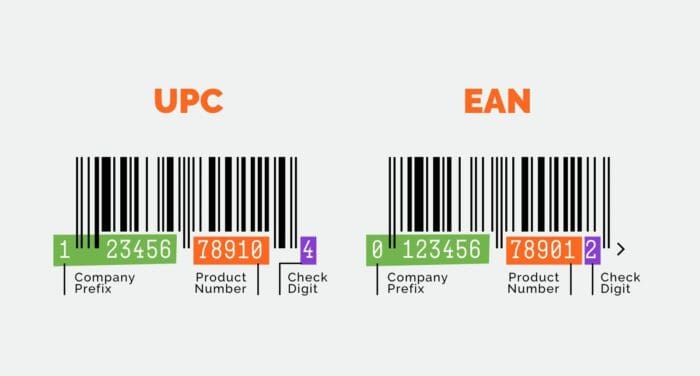
These types of product identifier codes may be used regionally but can be adapted for global ecommerce. Better yet, some modern barcode scanners are now equipped to accurately read both UPC and EAN codes, making them even easier to use globally.
A GTIN, or Global Trade Item Number, is also commonly used in international ecommerce. This is a 14-digit code that’s accepted as the global standard and is compatible with UPC, EAN, and JAN. Adding a 0 to any EAN will transform it into a GTIN.
Universal product code use cases: Industry-wide examples
To get a better idea of the different uses and benefits of universal product codes, let’s explore the applications across several industries.
Healthcare
Fresenius Kabi, a global healthcare company, used UPC codes to enhance the product labels of its entire portfolio of more than 700 products. This was a crucial move as the company needed to accommodate greater amounts of important data for a wide assortment of products, mostly in small packaging.
The company was able to leverage UPC codes to accommodate vital information about each dose of medication including lot and expiry data. This allowed clinicians to quickly verify that medications are in-date and not recalled, helping them to ensure patient safety and administer accurate patient care.
Ecommerce
Wellness brand Earthley’s products are all 100% natural, and there are dozens of them. With so many different products for sale on their ecommerce website, they knew they needed to implement UPC scanning in their warehousing and fulfilment operations to prevent confusion.
It was challenging to find an ecommerce fulfilment provider that would offer that capability – but with ShipBob, Earthley was finally able to leverage UPC verification to achieve the deep inventory visibility they needed. ShipBob’s best practices and warehouse management system (WMS) enabled Earthley to 10X their picking speed and double their warehouse productivity.
“We interviewed around a dozen different SaaS providers before ShipBob was on our radar, and I felt like none of them met our needs. They were all missing key features that you can’t run a business without.
For instance, using universal product code (UPC) verification — the process of scanning a product’s barcode to track inventory as it moves through fulfilment — was incredibly important to us. Half of the vendors’ systems could only do UPC verification on pick or pack, but not both, which leaves you prone to errors.
Then, I stumbled across ShipBob. From the very first call, I thought, “This is it.” ShipBob is a global fulfilment platform that wrote its own software instead of using someone else’s, and uses it to run their own outsourced fulfilment service. That was definitely a solution we could trust, and the solution we wanted.”
Ben Tietje, Co-Founder and CEO of Earthley
Restaurant Franchises
Weekly inventory was a major source of headache for franchises within the Subway network. Relying on a manual process often led to discrepancies between invoices, orders, and available stock, which called for time-consuming consolidating and troubleshooting.
After leveraging universal product codes based on GS1 Standards for inventory management, franchises were able to complete the process more accurately and within minutes instead of several hours.
These UPC barcodes also enabled distribution centres to be more accurate with their stock rotation so they could avoid delivering expired or short shelf-life products. Moreover, the codes proved to be a consistent data source for information about shelf life and storage temperature, which helped to ensure proper food handling.
A walkthrough of ShipBob’s product and order fulfilment process
At ShipBob, barcodes are used to streamline every step of the inventory management and order fulfilment process. Our fulfilment staff works hand-in-hand with advanced scanning tools to access and record product information while keeping track of inventory movement across the warehouse. To better understand how product codes contribute to the warehouse workflow at ShipBob, here’s a walkthrough of our process.
Receiving
When inventory arrives at our receiving bay, ShipBob’s experts check products into fulfilment centre storage by scanning the product barcodes. Our software then checks them against your Warehouse Receiving Order (WRO) to ensure we’ve received the right items and quantities.
“In my experience, ShipBob is a lot more clear and transparent about what customers can expect compared to the other 3PL we used. ShipBob’s warehouse receiving process and documentation are really detailed. I like being able to see the SLAs so I can know when receiving will be fulfilled.”
Peter Liu, Co-Founder of RIFRUF
Putaway
Received inventory next goes through a warehouse putaway process where our team scans the products to identify where and how they should be stored. This helps maintain consistency and organise inventory storage so that it is optimised for space, and so that products are safe, easily identifiable, and easily retrievable.
Picking
Once orders come in, each picker is assigned a picking list. They then travel to the designated location and scan each item’s barcode before adding it to their picking bin. The barcodes allow them to instantly verify that they’re picking the right products in the right quantities, which speeds up the process and minimises the risk of picking errors.
“With our previous 3PL, we were used to having about a half of a percent error rate (meaning 0.5%-1% of the DTC orders that we shipped out were wrong in some way). With ShipBob, I feel like our error rate is a hundred times less. I’m just stunned by how accurate our orders are, and our error rate is just vanishingly small now. Honestly, it’s been a game-changer for us, because we’re experiencing way fewer customer service issues than before, while growing 4x.”
Matt Crane, Co-Founder and Chief Science Officer at Semaine Health
Packing
At the packing bay, packers scan and verify each picked item before packing them into appropriate boxes. The barcodes help them double-check whether they’re packing the right items and shipping them out in the correct quantities.
Dashboard visibility
Throughout this entire process, a merchant can monitor and track inventory movement in real-time via ShipBob’s dashboard. This dashboard also provides key analytics for in-depth inventory management, such as SKU velocity, on-hand inventory levels, average fulfilment time and cost, and more.
“I can literally go into my ShipBob dashboard and see exactly what I want to see with a few clicks. I love that it’s a quick snapshot of everything that’s going on. I can literally not look at the ShipBob platform for 3 weeks, and then log in and within 10 minutes of analising the data, I know exactly where we stand in the business.
Even if I had to crunch some numbers, it would be just pulling a couple of reports and putting that data together – it’s so much easier than other solutions. As a person who relies on data analytics to run my business, I want to see my analytics exactly how ShipBob displays them to me.”
Mithu Kuna, Co-Founder and CEO of Baby Doppler
Product and inventory management magic with ShipBob
Using UPCs to organise your inventory is just one best practice for inventory management. As a global ecommerce enablement and fulfilment platform, ShipBob can help you leverage all sorts of tools and technology to optimise your ecommerce inventory strategy.
When you outsource your fulfilment to ShipBob, we take care of inventory storage and fulfilment for you. ShipBob can even add physical UPC barcode stickers to your products for you!
Once inventory is inside a ShipBob fulfilment centre, our proprietary WMS leverages UPC barcode scanning to track your inventory as it moves through your supply chain. The system then syncs that data back to your ShipBob dashboard to deliver real-time insights like:
- Up-to-date inventory levels for every SKU
- Automatic reorder point notifications when stock levels hit a threshold
- Current vs. ideal inventory distribution and allocation
- SKU velocity
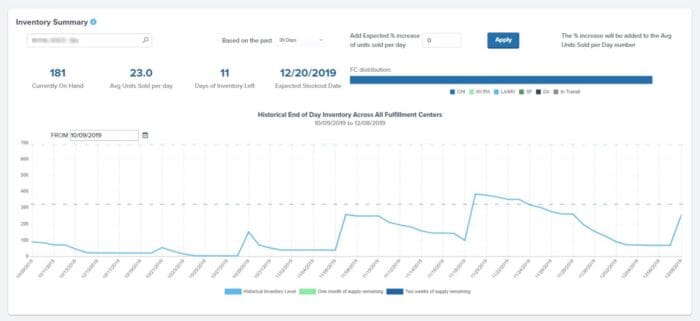
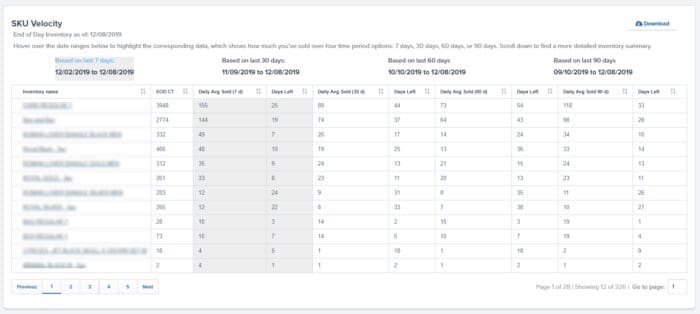
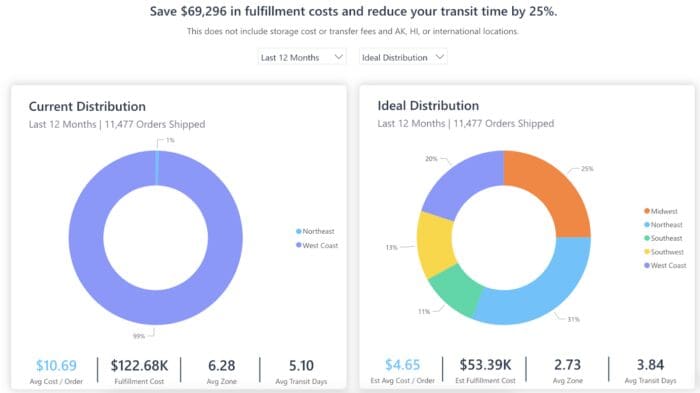
Ecommerce brands can also leverage this same WMS in their own warehouses to bring the same inventory visibility to their in-house operations.
Adding barcodes for all their products across all their channels to the ShipBob dashboard to keep track of everything in one place. This means you can have a single source of truth for all your inventory data, which minimises the risk of errors and overselling.
With ShipBob’s technology and best practices powering your logistics, you can make inventory management easier and focus on scaling your brand to new heights. For a deeper dive into how ShipBob can help your particular brand, click below to get in touch.
Universal product code FAQs
Below are answers to the most common questions about universal product codes.
How do UPCs differ from other product codes like EAN and JAN?
UPCs are a 12-digit code commonly used in regions like North America, Australia, and the United Kingdom. EAN and JAN are used in Europe and Japan respectively and are usually 13 digits.
Why are product codes so vital in ecommerce?
Product codes offer ecommerce businesses a standardized method of identifying products, which is crucial in inventory tracking and management, especially for brands selling on channels other than their official website, including marketplaces like Amazon or countries like Canada or Australia.
How does ShipBob use product codes to streamline order fulfilment?
ShipBob lets you add barcodes to your dashboard and uses them to access product information at various stages of inventory management and order fulfilment. Our pickers scan these barcodes to ensure that they’re picking the right items. Packers also scan barcodes to ensure that they’re packing and shipping out the correct items in the right quantities.
Can one product have multiple product codes?
Yes, a single product may have multiple product codes. While a manufacturer may assign a universal product code to the product, a retailer or reseller may also create and give a product a SKU number for internal use according to their own SKU labelling conventions.
What do terms like inventory codes, model numbers, and part numbers refer to? Are they the same as UPC?
An inventory code refers to a unique set of numbers assigned to each product in a company’s inventory. A model number is a code representing the components and features defining a product. Part numbers, in contrast, are universal product identifiers and may be used by manufacturers, wholesalers, distributors, and resellers alike.
In this sense, part numbers are similar to UPC numbers. Inventory codes, however, are more similar to SKU numbers, as they are only used for internal inventory tracking and management. Model numbers aren’t unique to one specific product, meaning that there may be 10,000 products with the same model number.
